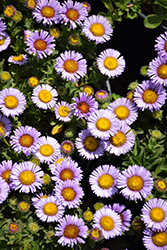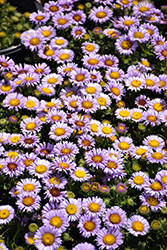It's all about ...
plants

Cape Sebastian Seaside Daisy
Erigeron glaucus 'Cape Sebastian'
Plant Height: 3 inches
Flower Height: 4 inches
Spread: 3 feet
Sunlight:
![]()
![]()
Hardiness Zone: 8a
Other Names: Beach Fleabane
Description:
A beautiful variety perfect for coastal plantings because of its tolerance to salt spray; lavender flowers with burgundy to gold centers cover the plant in spring to summer, then sporadically after; best with some irrigation; provide light inland shade
Ornamental Features
Cape Sebastian Seaside Daisy has masses of beautiful lavender daisy flowers with gold eyes at the ends of the stems from early spring to late summer, which are most effective when planted in groupings. The flowers are excellent for cutting. Its narrow leaves remain bluish-green in colour throughout the year.
Landscape Attributes
Cape Sebastian Seaside Daisy is a dense herbaceous evergreen perennial with a ground-hugging habit of growth. Its relatively fine texture sets it apart from other garden plants with less refined foliage.
This is a relatively low maintenance plant, and is best cleaned up in early spring before it resumes active growth for the season. It is a good choice for attracting bees and butterflies to your yard, but is not particularly attractive to deer who tend to leave it alone in favor of tastier treats. It has no significant negative characteristics.
Cape Sebastian Seaside Daisy is recommended for the following landscape applications;
- Mass Planting
- Rock/Alpine Gardens
- Border Edging
- General Garden Use
- Naturalizing And Woodland Gardens
Planting & Growing
Cape Sebastian Seaside Daisy will grow to be only 3 inches tall at maturity extending to 4 inches tall with the flowers, with a spread of 3 feet. Its foliage tends to remain low and dense right to the ground. It grows at a fast rate, and under ideal conditions can be expected to live for approximately 6 years. As an evegreen perennial, this plant will typically keep its form and foliage year-round.
This plant does best in full sun to partial shade. It is very adaptable to both dry and moist growing conditions, but will not tolerate any standing water. It is considered to be drought-tolerant, and thus makes an ideal choice for a low-water garden or xeriscape application. This plant should not require much in the way of fertilizing once established, although it may appreciate a shot of general-purpose fertilizer from time to time early in the growing season. It is not particular as to soil type or pH, and is able to handle environmental salt. It is somewhat tolerant of urban pollution. This is a selection of a native North American species. It can be propagated by division; however, as a cultivated variety, be aware that it may be subject to certain restrictions or prohibitions on propagation.
This plant is not reliably hardy in our region, and certain restrictions may apply; contact the store for more information.

